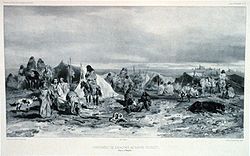- Tehuelche people
-
- Tehuelches redirects here. For other uses see Tehuelche.
Tehuelches Tehuelche camp, 1838 Total population 10.590[1] Regions with significant populations  Argentina
Argentina Santa Cruz,
Santa Cruz,  Chubut
Chubut4,351 [2]  Buenos Aires Province
Buenos Aires Province6,239 [3] Languages Religion No organized religion
Tehuelches (a Mapudungun word meaning "Fierce People") is a collective name for some native tribes of Patagonia and the southern pampas region. They are also called Patagons.[4]
It is possible that the stories of the early European explorers about the Patagones, a race of giants in South America, are based on the Tehuelches, because the Tehuelches are typically tall.[5] According to the 2001 census [INDEC], there were 4,300 Tehuelche in the provinces of Chubut and Santa Cruz, and a further 1,637 in other parts of Argentina.
Contents
History
 Cueva de las Manos, a site with Tehuelche cave paintings.
Cueva de las Manos, a site with Tehuelche cave paintings.
The Tehuelche people have a history of over 14,500 years.[6] Their pre-columbian history is divided in three main stages: a stage with highly-sized rock tools, a stage where the use of bolas prevailed over the peaked projectiles, and a third one of highly complex rock tools, each one with a specific purpose.[7] However, the nomadic lifestyle of tehuelches left scarce archeological evidence of their past.[8]
They were hunter-gatherers living as nomads. During the winters they were in lowlands and during the summer they migrated to the central highlands of Patagonia and the Andes Mountains. Although they developed no original pottery, they are well known by their rupestrian art.[6] The Spanish arrived in the early sixteenth century. On March 31, 1520, Ferdinand Magellan landed and made contact with the Tehuelche people, but the Spaniards never colonized their lands. It took more than 300 years before the Argentine government occupied the southern Patagonia.
Lifestyle
As nomads, Tehuelches lived with limited possessions, as they had to move across long distances. Their rock tools were usually made of obsidian or basalt, as those rocks were not hard enough as to be unmalleable, but neither soft enough as to break easily.[9] Those rocks, however, could only be found at specific regions of the Patagonia, so the Tehuelches had to make long journeys to renew their supplies.
The tehuelches hunted many species in the Patagonia, including whales, sea mammals, small rodents and sea birds; their main hunts were guanacos and Rheas. Both species were usually found at the same places, as the rheas eat the larvaes that grow at the Guanaco's manure.[10] Everything from the guanaco was exploited by the Tehuelches: the meat and blood were used for food, the fat to grease their bodies during winter, and the hide to make clothing and canopies.
There is little vegetal life in the Patagonia, but the Tehuelches gathered fruits that grew during summers. Those fruits were the only sweet foods in their diet.[11]
Language
The Tehuelche originally spoke Tehuelche, a Chon language, but later, with the Araucanization of Patagonia, many tribes started to speak variants of Mapudungun. The very name by which they are known, Tehuelche, comes from that language.
References
- ^ Población por pertenencia y/o descendencia en primera generación del pueblo tehuelche. Total país. Años 2004-2005.
- ^ Censo 2001 - Encuesta Complementaria de Pueblos Indígenas
- ^ Censo 2001 - Encuesta Complementaria de Pueblos Indígenas
- ^ Pre-Hispanic Chile
- ^ Fondebrider, Jorge (2003). "chapter 1 (Ámbitos y voces)" (in Spanish). Versiones de la Patagonia (1st edition ed.). Buenos Aires, Argentina: Emecé Editores S.A.. pp. 29. ISBN 950-04-2498-3.
- ^ a b Chiti, Jorge Fernández (1997) | see Monte Verde archaeological site near Puerto Montt. Cerámica indígena arqueológica argentina. Condorhuasi, p. 64. ISBN 9504380956. (Spanish)
- ^ Bernal, 18-20
- ^ Bernal, p. 17
- ^ Bernal, p. 28
- ^ Bernal, p. 29
- ^ Bernal, p. 30
Bibliography
- Bernal, Irma; Proaño, Mario Sánchez (2007). Los Tehuelche. Buenos Aires: Galerna. ISBN 978-950-556-422-4.
External links
- (German) Christine Papp: Die Tehuelche. Ein Ethnohistorischer Beitrag zu einer jahrhundertelangen Nicht-Begegnung. A dissertation. Universitãt Wien, 2002. (PDF)
- Native Patagonians - Contains primary sources and reference material.
Ethnic groups in Chile Indigenous peoples AraucanianOthersImmigration EuropeanOthersAfrican · Arab (Lebanese · Palestinian · Syrian) · Chinese · Indian · Japanese · Jewish · Korean · Taiwanese · Americans & CanadiansCategory:Ethnic groups in ChileCategories:- Indigenous peoples of the Southern Cone
- Patagonia
- Indigenous peoples in Argentina
- Indigenous peoples in Chile
- Pre-Columbian cultures
- Hunter-gatherers
Wikimedia Foundation. 2010.

